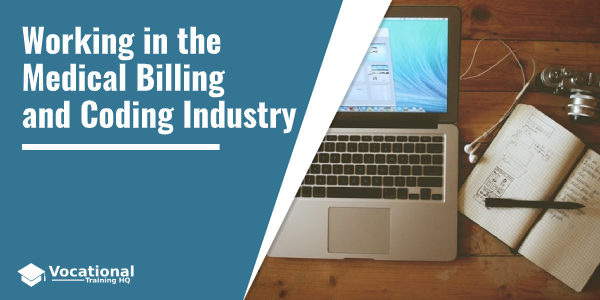Now is a good time to consider a career in the medical billing and coding industry.
The health care system in America is modernizing as a significant part of the population is retiring.
So the demand for health care professionals who can process data is increasing.
As the Bureau of Labor Statistics reports, the employment rate in the field of medical billing and coding should increase by 15% through 2024.
That translates into almost 30,000 new job openings.
Not only the number of job openings increases but also these jobs are fairly lucrative.
In 2016, the median salary for coders and billers was $38,040, which is $18.29 per hour as you start the career.
The top 10% of these professionals in the US make $62,840 per year, and in some states, even more.
There’s a number of factors influencing the growth of the medical billing and coding field.
An aging population is one of them together with an increasing focus on health informatics and data, as well as the digitalization of health records.
As electronic health records are predominating in the healthcare system, billing and coding professionals knowledgeable in computers have expanded job opportunities.
Let’s now talk about some of the daily tasks of medical billers and coders.
Remember, that one professional can sometimes perform the duties of the two positions.
Medical Coding
The day of coding professionals usually starts with reviewing the reports they have to code.
This is a relatively straightforward job.
They examine a doctor’s report of a procedure and determine the best way to translate it into code.
For instance, the report may say that a patient visited the doctor presenting a sore throat.
After examining it, the doctor suspected a common throat infection, streptococcus.
They performed a strep test.
The diagnosis was confirmed, so the doctor prescribed a week of amoxicillin, an antibiotic drug.
The coder would review this and use the ICD-10-CM and CPT code manuals to find the best way to code the procedure and diagnosis.
In this case, they use the CPT code 87880 for the strep test, a 00781-6041 CPT code for the prescription, and the J02.0 code of the ICD-10-CM manual for the diagnosis.
Then, they input the right codes into a form or, most likely, software, and move to the next report.
This is what they would do for the rest of the day.
For the most part, coding is straightforward, and coders become familiar with the codes used for common procedures in their area.
For example, a coder for a general practitioner will become familiar with general office visits code (99214) and flu shots (90658).
For each code, they should follow guidelines.
For instance, some conditions should be coded in a specific order.
However, there may be instances with a gray area or significant confusion in the code.
Guidelines can be intricate and particular conditions, symptoms, and procedures can get complicated.
If referring to manuals isn’t sufficient in some cases, coders can reach out to the coding community for advice.
Above everything, coders must ensure that the procedure codes and diagnosis codes correspond with each other.
If a procedure doesn’t make sense for a diagnosis, the claim can be rejected, which will greatly affect the reimbursement process.
Every medical office has a particular time of delay for medical reports.
Usually, it’s two to five business days, meaning the coder should complete it within five days after the doctor’s visit or procedure.
Meeting these deadlines provides for a smooth billing and reimbursement process.
Coders are responsible for managing deadlines that work timely and efficiently.
Medical Billing
Medical billers step in after medical coders finish their job.
Medical billers are responsible for creating accurate legal bills for the office of the healthcare provider and sending them to an insurance company or payer on time.
They are also in charge of sending out and collecting payments from patients.
During the day, medical billers perform a variety of processes.
They have to create accurate and formally correct claims, bills for patients, and check the accuracy in transaction reports.
First, medical billers take codes from coders in a form or through software and create a medical claim.
The claim contains a list of procedures, services, and costs that a healthcare provider sends to a payer to collect the reimbursement.
Theoretically, this is a simple process, but it can be very complicated.
The biller should confirm that all codes are correct.
This is somewhat a quality check after the medical coder makes their report.
To do this, medical billers should be familiar with medical terminology as well as the recent manuals of CPT, ICD, and HCPCS codes.
The medical biller should also be familiar with the insurance policy of the patient to determine the services and procedures provided by the healthcare provider that will be covered by the insurance plan.
Effectively, medical billers ensure that every code, and so every procedure, listed on the claim are billable.
This usually depends on the payer and their contract with a healthcare provider or patient.
Every insurer has its own rules and guidelines that determine which procedures can or cannot be covered under the contract of the policyholder.
Rates for specific procedures can be different in various medical facilities, so the created claim should correspond with the rates established by the provider.
Considering all these factors, medical billers create an accurate claim and send it to the payer.
Depending on the payer, the claim may have to go first to a clearinghouse or directly to the payer.
Particular payers and clearinghouses require specific software or forms.
For example, when sending a claim to Medicaid, the CMS-1500 form should be used.
After the claim is sent, the payer evaluates it, which is called adjudication.
Basically, the payer makes a decision on the amount of the bill they will cover and send it back to the provider as a transaction report.
Billers review this report and check its accuracy.
They ensure that reimbursements and charges meet the terms of the agreement between the payer and provider.
If the report is accurate, billers process a bill for patients.
It includes the explanations of which procedures are covered and for how much, and which procedures are the responsibility of the patient.
Lastly, medical billers handle collections.
If the patient is unable or unwilling to pay the bill, medical billers should send out reminders.
As the last resort, they may have to send the bill to the collections service.
This process can vary and depends on the policy of the healthcare provider.
Read the full guide: How to Become a Medical Biller and Coder



